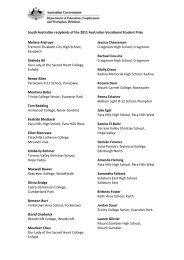Belonging, Being and Becoming - Early Years Learning Framework
Belonging, Being and Becoming - Early Years Learning Framework
Belonging, Being and Becoming - Early Years Learning Framework
You also want an ePaper? Increase the reach of your titles
YUMPU automatically turns print PDFs into web optimized ePapers that Google loves.
LEARNING OUTCOMES<br />
OUTCOME 4: CHILDREN ARE CONFIDENT AND INVOLVED LEARNERS<br />
Children transfer <strong>and</strong> adapt what they have learned from one context to another<br />
This is evident, for example,<br />
when children:<br />
• engage with <strong>and</strong> co-construct learning<br />
• develop an ability to mirror, repeat <strong>and</strong><br />
practice the actions of others, either<br />
immediately or later<br />
• make connections between experiences,<br />
concepts <strong>and</strong> processes<br />
• use the processes of play, refl ection <strong>and</strong><br />
investigation to solve problems<br />
• apply generalisations from one situation to<br />
another<br />
• try out strategies that were effective to solve<br />
problems in one situation in a new context<br />
• transfer knowledge from one setting to<br />
another<br />
Add your own examples from your context:<br />
36 BELONGING, BEING & BECOMING The <strong>Early</strong> <strong>Years</strong> <strong>Learning</strong> <strong>Framework</strong> for Australia<br />
Educators promote this learning,<br />
for example, when they:<br />
• value signs of children applying their<br />
learning in new ways <strong>and</strong> talk about<br />
this with them in ways that grow their<br />
underst<strong>and</strong>ing<br />
• support children to construct multiple<br />
solutions to problems <strong>and</strong> use different<br />
ways of thinking<br />
• draw children’s attention to patterns <strong>and</strong><br />
relationships in the environment <strong>and</strong> in<br />
their learning<br />
• plan for time <strong>and</strong> space where children<br />
can refl ect on their learning <strong>and</strong> to see<br />
similarities <strong>and</strong> connections between<br />
existing <strong>and</strong> new learning<br />
• share <strong>and</strong> transfer knowledge about<br />
children’s learning from one setting to<br />
another, by exchanging information with<br />
families <strong>and</strong> with professionals in other<br />
settings<br />
• encourage children to discuss their ideas<br />
<strong>and</strong> underst<strong>and</strong>ings<br />
• underst<strong>and</strong> that competence is not tied to<br />
any particular language, dialect or culture





